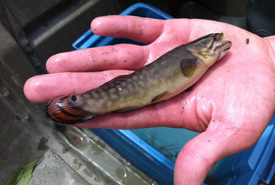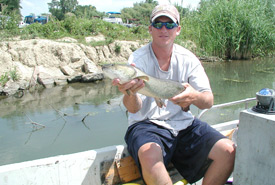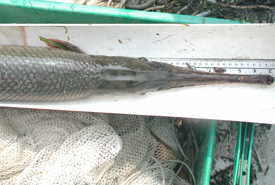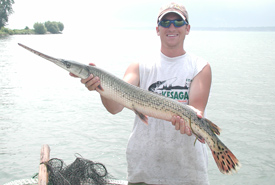Something's Fishy: The old fish and the lake

Juvenile bowfin from Ontario waters (Photo by Raechel Bonomo/NCC Staff)
What if I told you there are living fossils swimming in our waters right now? A few fish species that inhabit Canadian lakes and rivers have such ancient lineages, they are considered prehistoric. Some of these species swam alongside the dinosaurs! These fish are the veterans of Canadian waters, outlasting several other species by having the ability to acclimatize to changing habitat conditions.
The first time I saw one of these species I had no idea I was looking at one of Canada’s oldest fish species. There it was, with a round tail and black spot hugged by a bright orange ring: a bowfin. It began flipping around in the bucket in the swishing water as our boat rocked from the neighbouring tides. I had only ever seen illustrations and photographs of the bowfin in my field guides but there it was, in all its glory.
Bowfin

Dan Gibson with an adult bowfin, Detroit River, ON (Photo by Nick Lapointe/NCC Staff)
The bowfin is a warm water fish native to Ontario. Its long dorsal fin extends along the top of its body, ending at a rounded caudal fin. Males and juveniles have a large spot above the lateral line, near the caudal fin. This distinguishes them from the invasive northern snakehead, for which bowfin are often mistaken (however the snakehead does not yet occupy Canadian waters). Male bowfins will also sport deep forest-green colours when spawning.
According to Ontario Fish Species, bowfins may also be called dogfish and lawyer (although dogfish also refers to a small shark, and lawyer can be applied to the bowfin’s cold-water equivalent, the burbot).
Bowfins are usually found in sluggish, weedy waters, primarily in southern Ontario. Females can hold up to 64,000 eggs, which they protect from predation by males until they hatch. The bowfin is able to breathe water, contributing to its ability to survive poor water conditions for millennia.
But the bowfin is not the only dino-fish still swimming.
Longnose gar
Longnose gars have inhabited the Earth for more than 100 million years! They are characterized by their long, spotty body (adults can reach up to six feet!) and extended mouth, lined with hundreds of tiny teeth. This unique feature is where the gar gets its other names: needlenose gar or garpike (derived from the Anglo-Saxon word for spear).

Bird's-eye view of a longnose gar, Detroit River, ON (Photo by Nick Lapointe/NCC Staff)
This species can be found in warm, quiet areas of large bodies of water. In Canada, the longnose gar can be found primarily in lakes across Ontario and Quebec. On warm days and nights, gars may sometimes observed floating like driftwood near the surface of the water. This resourceful tactic is a form of mimicry, and enables the gar to drift stealthy and swiftly towards its prey.
The longnose gar is able to sustain a healthy population for several reasons. Its successful spawning behaviours include appearing in large, tight-knit schools around spawning areas in order to ensure complete and successful fertilization of eggs. During the spawning season, gars tend to travel up smaller streams in small groups — usually one large female two to four feet in length surrounded by three to six smaller males ones.
Longnose gars also have a long lifespan, surviving more than 20 years in the wild. The gar can survive in uncongenial habitats because of its highly vascularized swim bladder. This allows gars to swim to the surface and gulp air, supplementing their gill breathing in low-oxygenated waters.
Lastly, and perhaps most impressively, the longnose gar has developed an extensive coat of armour. Its interlocking scales have two layers made of isopedine (inner) and ganoin (outer) and are the reason the gar face little to no predation.

Dan Gibson holds up a longnose gar from Detroit River, ON (Photo by Nick Lapointe/NCC Staff)
Forget Jurassic Park, more like Jurassic Lake!
Next time you think dinosaurs are extinct, remember the living fossils swimming in our waters.
Water samples have been taken on all Nature Conservancy of Canada (NCC) lakes in Ontario, through the province's Lake Partner Program, which measures phosphorus levels and water clarity. This is a volunteer-run program administered by the Ministry of Environment and Climate Change that monitors water quality. NCC is helping to contribute to a province-wide database on inland lake health. NCC also tests our lakes for aquatic invasive species, mainly zebra mussels and spiny water-flea. Staff take every measure to ensure our lakes stay free of these invaders.
On one NCC property we developed an angler diary program, providing us with information on our fish population while still giving anglers the opportunity to fish. According to Ali Giroux, NCC’s acting coordinator of conservation biology of eastern Ontario, so far the program has been very successful in obtaining useful information of observations of the species in our waters.
By ensuring the health of the forests, rivers and streams and surrounding wetlands near water bodies, NCC is also contributing to the health of the lakes and thus the fish that live in these watersheds home.
Something’s Fishy is a monthly series written by NCC’s Communications Assistant, Raechel Bonomo, highlighting a species or group of fishes that inhabitant Canadian waters.


